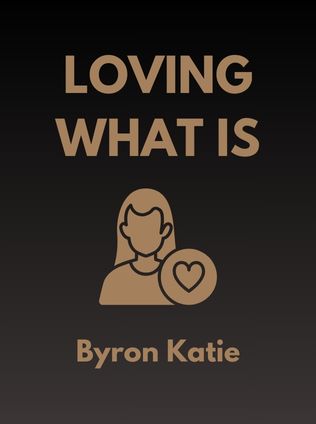
Loving What Is
Four Questions That Can Change Your Life
By Byron Katie
Published 01/2002
About the Author
Byron Katie is a spiritual teacher and author known for her powerful method of self-inquiry called "The Work." Born in 1942 in Texas, Katie’s journey to becoming a spiritual guide was not straightforward. For a decade, she struggled with depression, rage, and addiction, until a life-changing realization in 1986 transformed her understanding of life and suffering. This moment of clarity led her to develop "The Work," a process that helps individuals question the thoughts that cause their suffering and find peace within themselves. Katie's approach to spirituality is accessible and practical, emphasizing the power of questioning one’s thoughts to achieve inner freedom.
Katie’s teachings are not confined to any religious or spiritual tradition, making them universally applicable. Her approach is grounded in her own experience of transformation, which gives her work an authenticity and relatability that resonates with people from all walks of life. Over the years, she has shared her method with millions through her books, workshops, and public appearances, offering a path to peace and happiness that is rooted in self-inquiry and acceptance of reality.
Main Idea
The central premise of Loving What Is is that our suffering does not come from the events in our lives but from our thoughts about those events. Byron Katie argues that life is inherently good, and it is our resistance to reality that causes us pain. Through her method of self-inquiry, "The Work," Katie shows how we can question our thoughts and beliefs, and by doing so, release ourselves from the suffering they create. The book presents a powerful process for transforming the way we think and perceive the world, leading to greater peace and acceptance.
Katie’s philosophy challenges the common belief that external circumstances are responsible for our happiness or misery. Instead, she suggests that it is our thoughts about these circumstances that determine our emotional state. By questioning these thoughts, we can free ourselves from the mental constructs that trap us in cycles of suffering and open ourselves to the peace and joy that come from accepting life as it is.
Table of Contents
- Introduction: A Radical New Way to Live
- Part 1: Understanding Reality and Inner Peace
- Part 2: The Work – A Method for Inner Transformation
- Conclusion: Living in Harmony with What Is
Introduction: A Radical New Way to Live
In the introduction to Loving What Is, Byron Katie introduces the reader to a new way of living that challenges the conventional wisdom about happiness and suffering. She presents the idea that our suffering is not caused by the events in our lives but by our thoughts about those events. This perspective is both liberating and challenging, as it shifts the responsibility for our emotional well-being from external circumstances to our own minds.
Katie’s approach is rooted in her personal experience of awakening from a life of depression and suffering. Her realization that all suffering is caused by believing our thoughts led her to develop "The Work," a simple yet profound method of questioning the thoughts that cause us pain. The introduction sets the stage for the reader to explore this process of self-inquiry and discover a new way of living that is free from the limitations imposed by our minds.
By questioning our thoughts, Katie suggests, we can dismantle the mental constructs that keep us trapped in cycles of suffering. This radical approach to self-inquiry has the potential to transform not only our inner experience but also our relationships with others and the world around us. The introduction encourages the reader to approach the book with an open mind and a willingness to question deeply held beliefs, paving the way for a transformative journey of self-discovery.
Part 1: Understanding Reality and Inner Peace
In the first part of the book, Byron Katie explores the nature of reality and how our thoughts shape our experience of it. She argues that reality, as it is, is inherently good, and that our suffering arises when we resist this reality. According to Katie, the key to inner peace lies in accepting reality as it is, without judgment or resistance. This acceptance, however, is often hindered by the mind’s tendency to create narratives that distort our perception of reality.
Katie’s teachings align with various philosophical and spiritual traditions that emphasize the importance of acceptance and detachment from desires and judgments. For example, Stoicism teaches that our happiness depends on our ability to accept what is beyond our control, while Buddhism advocates for the release of attachment to outcomes as a path to enlightenment. Katie’s contribution to this discourse is her practical method for achieving this acceptance through "The Work."
Sign up for FREE and get access to 1,400+ books summaries.
You May Also Like
The Subtle Art of Not Giving a F*ck
A Counterintuitive Approach to Living a Good Life
By Mark MansonRich Dad Poor Dad
What the Rich Teach Their Kids About Money - That the Poor and Middle Class Do Not!
By Robert T. KiyosakiHow To Win Friends and Influence People
The All-Time Classic Manual Of People Skills
By Dale CarnegieFreakonomics
A Rogue Economist Explores the Hidden Side of Everything
By Steven D. Levitt and Stephen J. Dubner



















